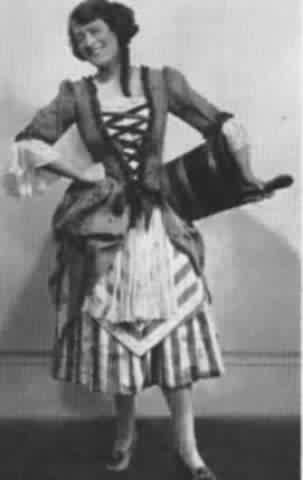|
|
|
 |
The usual practice of creating new G. and S. principals from the chorus was broken in 1922 when Mr. D'Oyly Carte heard Winifred Lawson sing the Countess in Figaro at the Old Vic (the nearest to Mozart's ideal Clive Carey says he ever witnessed); he promptly engaged her for the grand-opera part of Princess Ida in the first revival of that work since 1884.
Born in Wolverhampton, she was hailed after her first professional appearance as that rarity "a high soprano who sings perfectly in tune with a flexible voice and without tremolo". After London concerts and Glastonbury opera she joined the Old Vic Company where (as she wrote in her straight forward reminiscences "A Song to Sing-O", 1955) Lilian Baylis made many artists stars by personal encouragement. She also sang in the famous Cambridge performances of Purcell's "Fairy Queen" (the first since the seventeenth century).
Princess Ida with Bertha Lewis, Henry Lytton, Derek Oldham, Sydney Granville, Leo Sheffield, and Darrell Fancourt, resulted in her joining the company for the end of the tour in place of Helen Gilliland (who left to appear in musical comedy), then a year's contract, learning much by dressing with Bertha Lewis on tour, and finally becoming a permanent member of the company, and appearing at the rebuilt Savoy Theatre in 1929 after a tour of "Lilac Time" in place of Evelyn Laye.
In 1933 she joined the two-year-old Sadler's Wells Opera, then back to G. and S. in Australia. She resolved to retire in 1939, but sang G. and S. and other works for ENSA for the troops abroad, notably Alamein and Tobruk. On radio Mr. Carte gave her exceptional permission to use G. and S. records for her G. and S. reminiscences, and she later took part in the "Life of Gilbert and Sullivan" series and broadcast operas. She died in December 1961.
Her favourite parts were Ida, Elsie Maynard, Patience, and Casilda, her debut as Casilda resulting in Mr. Carte (though, like Gilbert, regarding tradition as good standard not automatic imitation) writing emphatically that smiling was wrong when puzzled as to which gondolier she was to marry. But her smile was never flirtatious or cheap; as Sir Malcolm Sargent wrote, she always appeared to be "a simple and attractive child-like creature taken completely by surprise."
| Artist Index | Main Index |